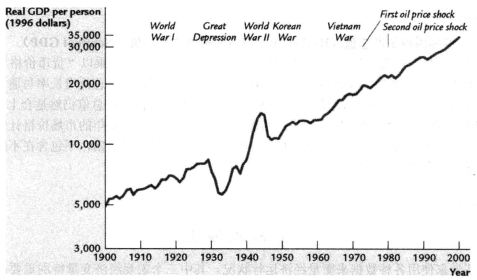Description of Economic Situation
Economists use many types of data to measure the performanc of an economy. Three macroeconomic variables are especially important: real gross domestic products (GDP), the inflation rate, and the unemployment rate. Real GDP measures the total income of everyone in the economy (adjusted for the level of prices). The inflation rate measures how fast prices are rising. The unemployment rate measures the fraction of the labor force that is out of work. Macroeconomists study how these variables are determined, why they change over time, and how they interact with one another.
The figure shows real GDP per person in the United States. Two aspects of this figure are noteworthy. First, real GDP grows over time. Real GDP per person today is about five times its level in 1900. This growth in average income5 allows us to enjoy a higher standard of living than our great-grandparents did. Second, although real GDP rises in most years, this growth is not steady. There are repeated periods during which real GDP falls, the most dramatic instance being the early 1930s. Such periods are called recessions if they are mild and depressions if they are more severe. Not surprisingly, periods of declining income are associated with substantial economic hardship.

参考译文
经济状况的描述
经济学家使用各种数据来衡量经济运行状况。其中三个宏观经济变量特别重要:实际国内生产总值(GDP)、通货膨胀率和失业率。实际国内生产总值衡量经济中所有人的总收入(根据物价水平进行调整)。通货膨胀率衡量物价上涨的速度。失业率衡量失去工作的劳动力的比例。宏现经济学家研究这些变量是如何被决定的,为什么会随着时间推移而变化,以及它们相互之间的关系。
图表显示美国的人均实际GDP。图表有两点值得注意。第一,实际GDP随着时间的推移而增长。现在的人均实际GDP是1900年的5倍左右。平均收入的这种增长使我们能够享受到的生活水平高于我们的祖父母。第二,虽然实际GDP在大多数年份是增长的,但这种增长并不稳定,其间存在多次实际GDP下降的时期,最严重的例子是20世纪30年代初期。如果实际GDP小幅度下降,这些时期称为衰退,如果实际GDP减少较为严重,这些时期称为萧条。毫无疑问,收入减少时期与严重经济困难是相关的。
责任编辑:admin
上一篇:商务翻译例文——适者的复兴/Revival of the Fittest
下一篇:如何翻译英文财经数据?

微信公众号搜索“译员”关注我们,每天为您推送翻译理论和技巧,外语学习及翻译招聘信息。